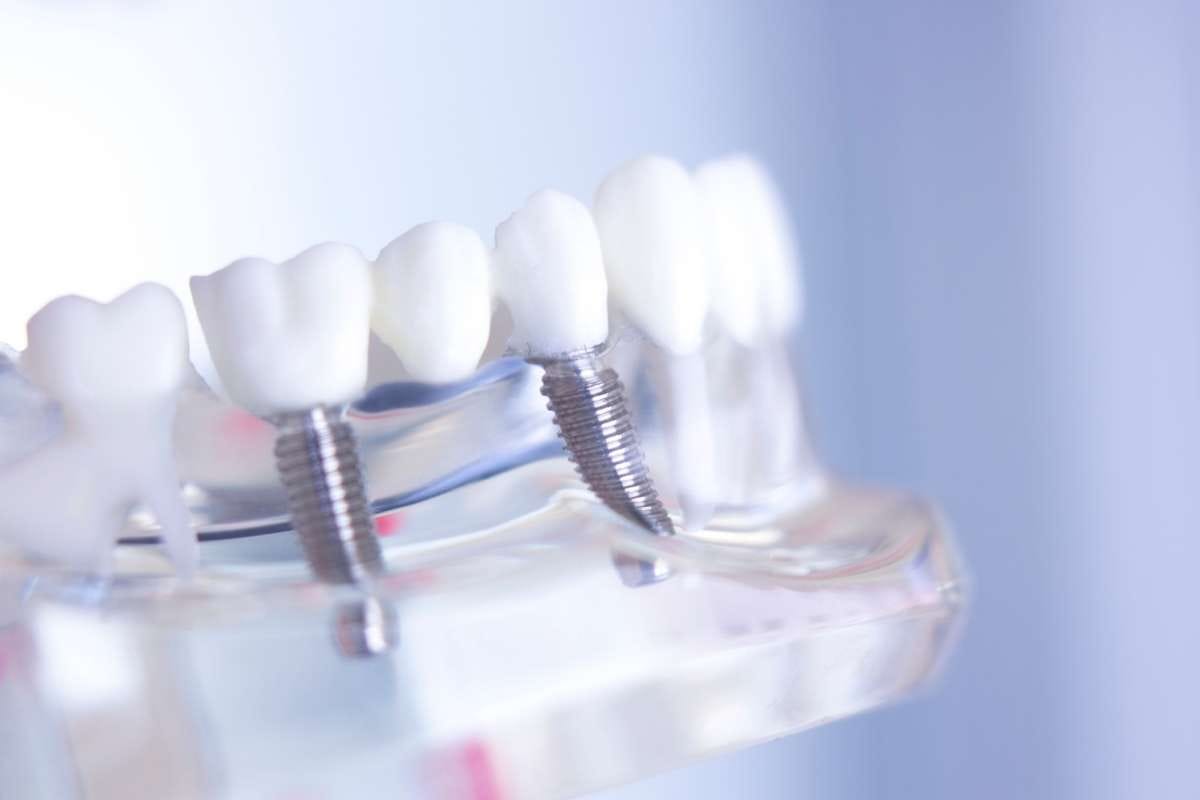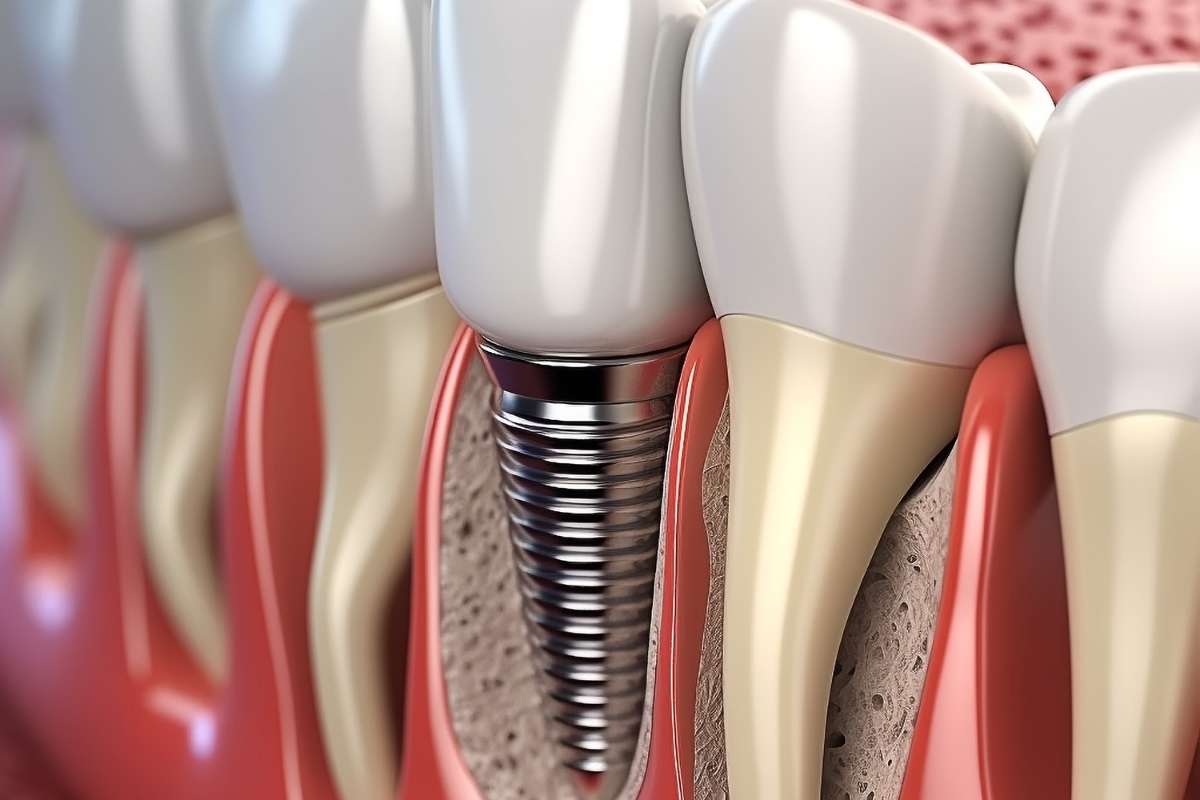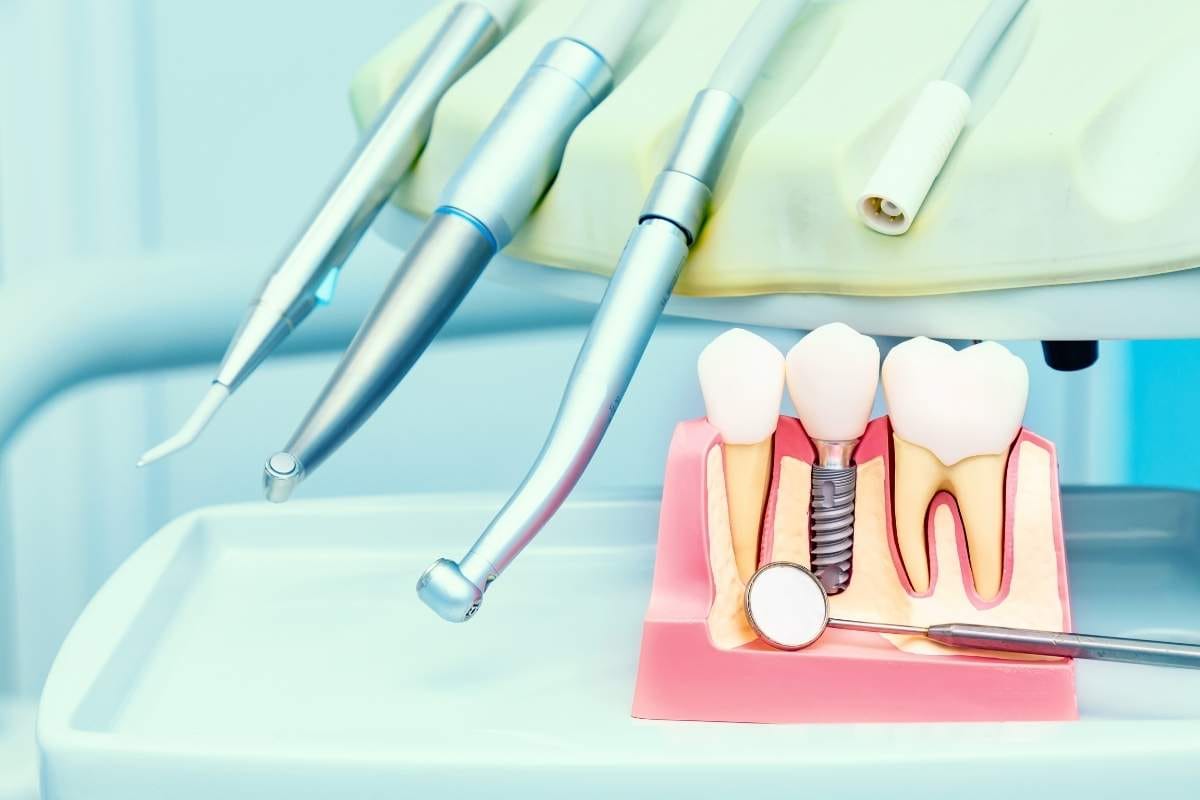Dental Implants
The question “What is a dental implant?” is frequently asked by individuals who care about their oral health and are seeking a permanent solution for missing teeth. Today, implant treatment is one of the most effective methods for restoring both dental aesthetics and function. It stands out for its long-lasting results and is considered one of the best options for those who desire a natural-looking smile while improving chewing and speech functions.
Patients who are considering implant treatment often ask: “How is dental implant treatment performed?” This method provides a healthy and permanent solution for replacing lost teeth. It offers both aesthetic and functional advantages and is carried out in multiple stages. Understanding how dental implant treatment works helps patients make informed and confident decisions.
Implant treatment is not only an aesthetic procedure, it also fulfills essential functional needs. Therefore, the question “Who is suitable for dental implant treatment?” is especially important. Before beginning the procedure, factors such as the patient’s overall health, jawbone density and oral hygiene are carefully assessed. Consulting with a specialized dentist is essential to determine whether the patient is an appropriate candidate and to ensure a successful outcome.
Since 1999, ATA PERA Dental Center has been a trusted name in the field of dental implants.
What is an Implant?
Implants are artificial tooth roots, usually made of biocompatible materials such as titanium, that are placed in the jaw to replace missing teeth. The most basic answer to the question “What is an implant?” is that it offers the most permanent solution, both aesthetically and functionally, for individuals who have lost teeth. These structures integrate with the jawbone over time and function like natural tooth roots.
Dental implants are among the most effective treatment methods developed to replace missing teeth and protect the jawbone. Tooth loss not only creates aesthetic concerns but can also lead to jawbone resorption, which may cause more serious health issues over time. Therefore, implants not only replace missing teeth but also help maintain jawbone health.
Implants, known for their durability and long-lasting nature, restore chewing function and help prevent speech disorders. They also play an important role in preserving facial aesthetics and boosting individuals’ self-confidence.
How is Dental Implant Treatment Performed?
Dental implant treatment is a gradual and carefully planned process. Each stage is tailored to the patient’s oral health, jawbone condition and suitability for treatment. The procedure is carried out step by step to ensure a successful and long-term result. It not only addresses tooth loss but also helps preserve the jawbone structure.
1. Examination and Evaluation Process
The first step involves a thorough evaluation of the patient’s oral and jaw health. At Ata Pera Dental Clinic, we use advanced panoramic X-rays and 3D imaging technology to assess whether the jawbone is suitable for implant placement. During this stage, factors such as bone density, gum health and overall oral structure are examined in detail to create a personalized treatment plan. In order to maximize the success of the implant procedure, we also consider the patient’s general health, any chronic illnesses and the condition of their immune system. This personalized planning is essential to achieve the best and most durable outcomes.
2. How to Determine Jawbone Suitability?
For the long-term success of an implant, the jawbone must have sufficient density and volume. If the bone is inadequate, additional surgical procedures such as bone grafting or a sinus lift may be required. This critical step ensures that the implant integrates firmly with the bone and is one of the stages that demands the most attention during implant treatment.

3. Surgical Procedure Process
Implant placement is carried out by the specialist dentists at Ata Pera Dental Clinic in a sterile environment and under local anesthesia. During this stage, the gum is carefully opened and a suitable socket is prepared in the jawbone for the implant. Our experienced physicians use the most appropriate placement technique based on the patient’s oral anatomy and the condition of the missing teeth.The duration of the procedure may vary depending on the number of implants and the structure of the jaw. Postoperative effects such as swelling, mild pain and tenderness around the implant site are normal and usually subside within a few days. During this period, we provide our patients with pain management and personalized aftercare instructions to ensure a smooth and comfortable healing process.
4. Fusion Process of the Implant with the Jaw Bone (Osseointegration)
Osseointegration is the biological process through which the implant fuses with the jawbone, allowing it to function as a natural tooth root. This phase typically takes between three to six months and is critical for ensuring the long-term stability and durability of the implant. During this period, patients must maintain excellent oral hygiene, avoid smoking and excessive alcohol consumption and carefully follow their dentist’s instructions. Among all stages of implant treatment, osseointegration is one of the most essential, as it directly determines the success of the procedure.

5. Prosthetic Tooth Placement Phase
After the osseointegration process is successfully completed, a custom-made prosthetic tooth is placed on the implant. This prosthesis is carefully designed to match the patient’s existing teeth in terms of shape, color and function. Depending on the individual case, either a fixed (permanent) or removable prosthesis may be selected to ensure optimal fit and comfort. In the final step, the prosthesis is precisely adjusted and fitted, allowing the patient to chew, speak and smile naturally and comfortably.
For those curious about how dental implant treatment works, the steps outlined above provide a clear overview of the entire process. Attention to detail at each stage is essential for achieving long-term success and patient satisfaction.
What are the Types of Implants?
The techniques and materials used in implant treatment are determined based on the patient’s specific needs. Various types of implants have been developed for different situations. The choice of implant depends on the patient’s jawbone structure, the condition of the missing teeth and overall oral health.
Endosteal Implants (Placed Inside the Jawbone)
Endosteal implants are the most commonly used type of dental implant. They are placed directly into the jawbone and are typically made of titanium. Shaped like screws or cylindrical rods, these implants integrate with the bone to form a strong foundation. They are an ideal solution for patients with healthy jawbones and sufficient bone density.
Subperiosteal Implants (Placed Under the Gum)
Subperiosteal implants were developed for patients with insufficient jawbone. These implants are placed under the gum, sit on the upper part of the bone and are supported by a special metal frame. It is preferred as a suitable alternative for patients with high bone loss and who cannot undergo bone grafting.
Zygomatic Implants
Zygomatic implants were specifically developed for patients with insufficient upper jawbone. They can be anchored directly in the cheekbone (zygoma) and do not require jawbone support. These implants are longer and more durable than standard implants, making them an ideal solution for patients with advanced bone loss. Zygomatic implants enable implantation without the need for a traditional bone grafting procedure and allow patients to receive permanent teeth in a shorter timeframe.
All-on-4 and All-on-6 Systems
The All-on-4 and All-on-6 systems are designed for patients with complete edentulism. In these treatment methods, all teeth are secured by placing either four or six implants in the jawbone. These systems offer a more stable solution compared to removable dentures and provide patients with both aesthetic and functional comfort. They are a popular choice because they can be implemented in a short period and facilitate a fast healing process.
Bone Graft
When the jawbone does not have sufficient volume, a bone graft is applied to ensure that the implant can anchor securely.In this procedure, bone tissue taken from the patient’s own body or biocompatible synthetic materials is used to strengthen the jawbone. These materials, also known as bone grafts or bone powder, support the regeneration of bone tissue and enable the successful placement of the implant. The bone grafting process may take several months, depending on the condition of the jawbone, after which the implant treatment can begin.
In Which Situations Is Implant Applied?
Implant treatment is one of the most effective functional and aesthetic solutions for individuals with tooth loss. Compared to traditional prostheses and bridge treatments, this method offers more comfortable and long-lasting results and can be applied in various types of tooth loss. Implant treatment is planned individually, based on the type of tooth loss and the condition of the jawbone.
Single Tooth Loss: For patients who have lost a single tooth, an implant allows the missing tooth to be replaced without affecting the surrounding healthy teeth. Unlike traditional bridge treatments, which require support from adjacent teeth, implant treatment preserves the natural tooth structure. This provides both an aesthetic and long-lasting solution.
Multiple Tooth Loss: Implant-supported prostheses are ideal for patients with multiple missing teeth. With implants placed at specific intervals, fixed dental prostheses can be applied. This method restores most of the patient’s natural chewing and speaking functions.
Complete Tooth Loss (Edentulism): In cases of complete edentulism, implant-supported full dentures can be applied for patients with no remaining teeth in the upper or lower jaw. Using systems such as All-on-4 or All-on-6, all teeth can be fixed using fewer implants. This approach offers a much more stable and comfortable alternative to removable dentures.
As an Alternative to Bridges and Dentures: Implants provide a more natural and long-lasting solution compared to traditional bridge and denture treatments. Unlike dentures, which require frequent removal and care, implants offer a permanent and durable tooth structure.
Bone Loss Cases: Implant treatment can still be performed in patients with jawbone resorption due to tooth loss. Using advanced surgical techniques such as bone grafting or sinus lifting, the jawbone can be strengthened to support implant placement. This makes implant treatment a viable option even in cases of advanced bone loss.

Who Can Receive Dental Implant Treatment?
Dental implant treatment offers a long-term and permanent solution for individuals with a healthy oral structure. However, not every patient may be suitable for this procedure. For implant treatment to be successful, the patient’s general health, jawbone structure, and gum health must be carefully evaluated. The following groups are considered suitable candidates for implant treatment:
- Individuals with Healthy Gums and Jawbone: For the implant to properly fuse with the bone, the jawbone must have adequate density and the gums must be free of disease. In cases where gum disease or bone loss is present, preliminary treatments are required.
- People with Sufficient Jawbone Structure: Implant treatment tends to be more successful in individuals whose jawbone has enough thickness and density. If there is bone loss, additional procedures such as bone grafting or sinus lifting can be performed to prepare the area.
- Individuals Over 18 Years of Age (With Completed Jaw Development): Implant treatment is generally not recommended for young individuals whose jaw development is incomplete. Most patients over the age of 18 are considered suitable, as their jaw structure has fully matured.
- Special Evaluation for Diabetics and Individuals with Osteoporosis: Patients with diabetes or conditions that affect bone health, such as osteoporosis, must undergo a thorough evaluation before receiving implants. Proper control of blood sugar levels significantly impacts treatment success. Likewise, osteoporosis patients must be assessed to ensure their bone density is adequate for implant placement.
Taking these factors into account, it is essential to create a personalized treatment plan for each patient. Implant procedures are carefully tailored to the individual’s general health and jaw structure to achieve optimal results. The most suitable treatment method is determined after a comprehensive examination by the specialist dentists at Ata Pera Dental Clinic.
What are the Benefits of Dental Implant Treatment?
Dental implant treatment offers both aesthetic and functional benefits by providing a permanent and healthy solution for replacing missing teeth. Compared to traditional dentures and bridge treatments, implants offer a more durable and comfortable structure and can last for many years with proper care.
Permanent and Long-Lasting Solution: Implants are made of biocompatible materials such as titanium, allowing them to integrate with the jawbone and provide a long-term solution. With proper maintenance, implants can last for many years, with a lifespan comparable to that of natural teeth.
Appearance and Function Close to Natural Teeth: Implants offer the closest aesthetic result to natural teeth and restore chewing and speaking functions, providing patients with great comfort. A natural-looking smile is achieved through the customized design of the prosthetic teeth.
Chewing Comfort and Ease of Speaking: Since implants are fixed in place, they do not move while eating or speaking. This allows patients to continue their daily activities comfortably, without the slipping or shifting issues often associated with traditional dentures.
Preservation of the Jawbone and Prevention of Bone Loss: Implants help prevent jawbone resorption that typically occurs after tooth loss. By integrating into the jawbone like a natural tooth root, they help maintain bone density and preserve the structure of the jaw over time.
Replacing Missing Teeth Without Damaging Adjacent Teeth: Unlike traditional bridge treatments that require adjacent healthy teeth to be filed down, dental implants are placed directly into the area of the missing tooth. This approach preserves neighboring teeth and offers a more conservative and long-lasting solution.
Aesthetic Improvement and Boost in Self-Confidence: Tooth loss can significantly impact a person’s smile and social interactions. With dental implant treatment, patients regain a natural-looking smile, which in turn enhances their self-esteem and overall confidence.
Comfort and Ease of Use: Unlike removable dentures, implants are fixed in place and do not require removal or special maintenance. They can be cared for just like natural teeth, with regular brushing and routine dental check-ups. Furthermore, implants eliminate common denture-related issues such as slipping, clicking or discomfort during speaking and eating.

What Should Be Considered Before Getting Dental Implants?
Although implant treatment offers a long-term and effective solution, there are several important factors to consider before beginning the process. The patient’s jaw structure, oral health and overall medical condition must be thoroughly evaluated. Understanding the factors that influence treatment success helps patients make more informed decisions.
- Detailed Examination and Treatment Planning: Before starting the procedure, a comprehensive examination should be conducted to determine the most suitable treatment approach. Assessing the jawbone structure using X-ray or 3D imaging technologies ensures accurate planning for optimal implant placement.
Treatment Process and Timing:Implant treatment is a gradual process. Therefore, it is important that patients fully understand each step and allocate sufficient time to complete the treatment. Each phase, including the osseointegration period, must be carefully planned to ensure long-term success.
Choosing a Specialist Dentist: Dental implant placement requires expertise and experience. For this reason, selecting a dentist who is highly skilled and specialized in implantology is essential before beginning the treatment. Proper planning by a qualified professional minimizes potential complications during and after the procedure.
Implant Brand and Quality: The quality of the implant brand used is a key factor influencing the long-term success of the treatment. Implants made from high-quality, biocompatible materials integrate more effectively with the jawbone and offer a longer-lasting, more reliable solution.
Jawbone and General Oral Health Status: For implant placement to be successful, the jawbone must have sufficient density. In patients with weakened bone structure, supportive procedures such as bone grafting may be necessary. Additionally, maintaining good oral and gum health is essential for a smooth and successful treatment process.
Post-Procedure Care and Nutrition Recommendations: Proper post-treatment care is crucial to enhance the success of implant treatment. Patients should maintain excellent oral hygiene and avoid hard or sticky foods that may irritate the gums. Regular dental check-ups are important to monitor the condition of the implant and ensure long-term stability.
Effects of Smoking and Alcohol Use on Treatment: Smoking and alcohol consumption can significantly reduce the success rate of implant treatment. Smoking delays healing, while alcohol increases the risk of infection. Therefore, it is strongly recommended to stop these habits before and after the procedure to ensure the best outcome.
This guide is designed to help you make an informed decision about dental implant treatment by providing insight into key topics such as what an implant is, the stages of implant treatment, how the procedure is performed, who is eligible for implant treatment and the different types of implants.
At Ata Pera Dental Clinic, we are committed to offering you the best solutions for a safe and effective implant treatment experience, supported by our team of experienced specialist dentists and advanced technological equipment. For more detailed information and to begin your journey toward a healthy smile, please feel free to contact us.

